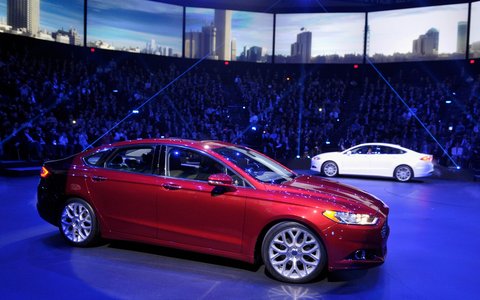 Mike Cassese/ReutersThe 2013 Ford Fusion.
Mike Cassese/ReutersThe 2013 Ford Fusion.
10:25 a.m. | Updated
Introduced on Monday, Jan. 9: 2013 Ford Fusion.
What is it? The redesigned Fusion is Ford’s all-in bet in a hypercompetitive midsize class. With Camrys, Malibus, Accords, Passats and Sonatas all striving to strike an optimal — if not terribly stirring — balance of fuel economy, sound driving dynamics and premium features at a reasonable price, it’s a huge challenge by any measure.
Is it real? The Fusion, which will carry the Mondeo name in Europe and Asia, is a critical component of the so-called One Ford strategy. It’s every bit the global car that the Fiesta, Focus and C-Max are, and it carries big expectations.
What they said: Discussing the wide-ranging Fusion line-up, Ford chief executive Alan R. Mulally predicted a coming shift in market tastes. “The majority of people near-term are going to hybrids. They’re just so flexible,” Mr. Mulally said at the automaker’s press conference here Monday morning. He added that Ford would build gas-only, hybrid and plug-in Fusions on the same production line, giving it the flexibility to build whichever versions that were in demand.
What they didn’t say: This is a mainstream car, designed to sell in the hundreds of thousands every year against formidable competitors. Consequently, Ford will get a huge benefit if the Fusion is a blockbuster. But it would be a serious blow to the automaker if the car failed to gain traction with buyers.
What makes it tick? The front-wheel-drive Fusion, assembled at Ford’s plant in Hermosillo, Mexico, offers a fistful of powertrains, though Ford is only offering estimated output figures for each. The standard engine, a 2.5-liter 4-cylinder, is projected to generate 170 horsepower. Optional engines include a 179-horsepower turbocharged 1.6-liter EcoBoost 4-cylinder and a 237-horsepower turbocharged 2-liter 4-cylinder EcoBoost. The 2-liter is only available to customers who opt for the all-wheel-drive sedan.
The base model is offered with a 6-speed automatic transmission, while the 1.6-liter EcoBoost can be specified with either the auto or a 6-speed manual. The all-wheel-drive model receives a continuously variable automatic.
With lithium-ion batteries replacing the outgoing model’s nickel-metal hydride units, Ford is promising class-leading fuel economy from the Fusion Hybrid, with an estimated E.P.A. rating of 47 miles a gallon in city and 44 m.p.g. in highway driving. But the real efficiency showcase is the Fusion Energi, a plug-in hybrid said to be capable of returning the equivalent of 100 m.p.g. or higher when operating solely under electric power. A non-EcoBoost 1.6-liter 4-cylinder engine supplements the electric motor. Ford did not reveal specifications for the Energi’s battery pack or motor, or what the car’s estimated purely electric range would be.
How much, how soon? The gas models and hybrid will arrive in the summer, with the Energi scheduled to arrive in showrooms this fall. Although prices haven’t been released, for the Fusion to be competitive, it would be expected to fall in the $21,000-$28,000 realm — the Energi being the wild card, which would probably list for over $30,000.
How’s it look? The design manages to be clean and uncluttered while projecting a strong personality. Buyers put off by the previous-generation car’s slatted chrome bars on the grille should be pleased by the new, slightly trapezoidal treatment, evocative of the Focus Electric and the Evos concept shown at the Frankfurt auto show last September.
Article source: http://feeds.nytimes.com/click.phdo?i=cc403c6ba10741413c192b08087c8b3d